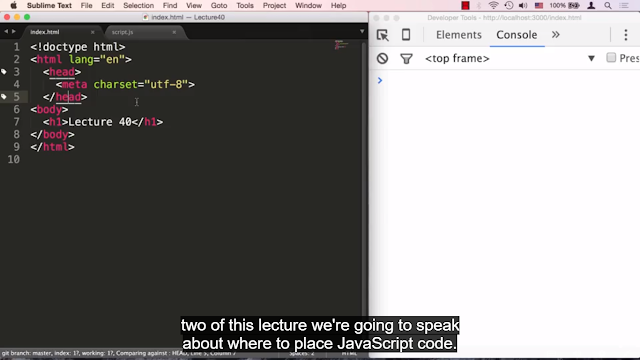SOURCE: https://www.youtube.com/watch?v=aG2m9ZuGxTE&t=9s
inside some JavaScript file, or for CSS, for that matter, at this point. Sublime is going to try to help me out a complete as I type. The problem is that Sublime at this point thinks that all 40 lectures from beginning to end and are part of our project, and every single one of them as you can see has some CSS in it. Some of them when we get to bootstrap already have some JavaScript in it as well. So all that is going to be try to put into the context and put in to memory of Sublime. To try to help us out. So that's going to create some slowness, so let's go ahead, and redo our work space, and only include the lecture, the particular lecture we're on, in our work space. Okay so how do we do that? Well if we go to the command line, and let's go ahead, and CD into our lecture folder. 40. There is a command that Sublime comes with and it works on Windows, Linux, or Mac, and this command allows you to start Sublime in a particular directory. So, in this case, I mapped it to the keyword sublime and if I say dot, which at this point is the current directory, and open it up. Sublime will open the Sublime editor, and it will only have that particular folder, as its kind of a work space. So nothing else will be included. So let's go ahead and do that, and I will rearrange my windows, so we can see a little bit better. Now how first of all did I get to this sublime, Or supple as it's called actually this command. Well, if we go to the browser, I opened up a couple of links for you which I will include right after this lecture that will allow you to go step by step, and it will explain to you how to set this up so you could actually do this yourself. Again, it works on mac which is very similar to lynx so you can pretty much follow the same directions, except maybe for the fuller structure, and on windows the same way, this is another link for windows, you could certainly follow this command line tutorial. So you could open sublime for whatever directory you want. Okay so here I am I rearrange my windows a little bit so now I am sitting in lecture 40 in index.html, and here's our index.html. So we just like before can start brows sync and have the code that we write sync together with the browser. So we won't have to refresh that anymore. So let's go back to our command line, and we are in lecture 40 right here, and as you can see, it's in examples lecture 40. Now let's go ahead start the browser-sync. We'll say browser-sync, it's the same command as we did before. Start, server, directory, and so on, and we do need star star star because If we actually go back, you'll see that we have a js directory, and if we do a ls in that js directory you'll see that there's a script.js in there. So if we change something in that script.js. We want that to be reflected in the browser as well. So let's go ahead and start our browser sync, together with our star, star, star, so it will go ahead and go down directories as well. We'll start it up and we'll go to our browser, and you can see here it loaded up the page, but didn't execute the index.html yet. So let's go ahead and click on that, and here's our lecture 40 heading one. Okay, so what we're actually interested in is not so much the page anymore. Is we're interested in the JavaScript that is going to run, and chrome developer tools which is part of chrome browser is a great tool to have and to actually use. So what we're going to do is we're going to do Cmd+Alt+I, and on Windows I believe it will be Ctrl+Alt+I, so we'll go ahead, and open Chrome Developer Tools, and this is basically where we've kind of been living for the last so many lectures, we've been living in the elements tab. Where we're going to be living from now on, at least for a little while, is in a consult tab. So when we click the consult tab, this is where the JavaScript, and the JavaScript messages are going to show up. Now, we don't really need to see this lecture 40 thing all the time and I do want this window to have a little bit more space. So, the way we could do that is by going this dot, dot, dot, and actually undock this whole panel. So, we'll do that right now and that just threw out this panel all the way here. So, what we're going to do is, we're going to make it a little bit smaller, and we'll align it just like so, and now we can have our full blown JavaScript console right in front of us as we write our code. So in this here, in the sublime text, we could try to make this a little bit more minimized, but what we actually should do is just to close it all together, because we know where we are. So at this point, we'll go ahead and open up our script, the JavaScript.js, and now, index.html, and we'll do Cmd+K+B or Ctrl+K+B on Windows. And we'll just close the file explorer Okay, so now that we have our development environment the way we want it, in part two of this lecture we're going to speak about where to place JavaScript code.




















0 comments:
Post a Comment